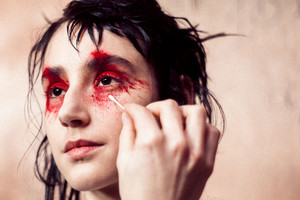Månvarv: Lotta Törnroth’s Dialogue with Loss
Written by Natalia MunteanLotta Törnroth’s exhibition Månvarv at Konstnärshuset explores grief, memory, and the lingering presence of loss following her father’s death. Through photography, she reflects on absence, particularly through images of her mother, who evolved from a reluctant subject to a central figure in the work. An intimate installation features a photograph of Törnroth with her father, a “lens lice” who loved the camera. The moon, captured annually since his passing, becomes a recurring motif, symbolising both solace and continuity. Curated by Koshik Zaman, the exhibition is part of a broader focus on contemporary photography, together with Spoiled Image, and runs from May 10 to June 7.
Natalia Muntean: The exhibition centres on your annual tradition of photographing the full moon, which started as a way to cope with your father’s impending death. Has the act of photographing the moon shifted from distraction to something else?
Lotta Törnroth: It has been a shift from distraction to something I really need to do, almost like an obsession. Photographing the moon has become a treasure to me, almost more important than going to my father’s grave.
NM: From what I gathered, in the exhibition, your father appears directly in only one photograph, yet his presence lingers elsewhere, through your mother, the moon, or the “spirit” mentioned in the text. How did you decide what to exclude from the visual narrative?
LT: My father is all over the exhibition, as you say, but I decided to present only one image of him in this show. It’s a photograph of the two of us together, and this image is crucial for the narrative of the exhibition, so I chose to let it shine on its own.
NM: Your mother, initially reluctant, became a recurring figure in the project. What dynamic were you trying to capture through her? Did her role change after your father’s death, and did the camera alter your relationship with her?
LT: I started photographing her at the same time as my father. In the beginning, I was inspired by Freud and the theory of psychological projection. But photographing her has always felt more violent, and when it became clear that it was my emotions I wanted to show through her, I focused on my father. Then, when he died, something happened. After a while, she was happier, and I saw her through the camera in a different way. Which also made those photographs lighter and more playful.
NM: You’ve committed to photographing the moon annually for the rest of your life. Has the ritual itself become a form of dialogue with your father, or does it serve another purpose now?
LT: I write in my book Lunar Cycles that I photographed the moon to show it to my father. I know how much he would have loved to see it. And I find the act of photographing is a way of returning to that feeling I had at first. That act is in my body, not so much in the framed photograph.
NM: Are there moments of grief you couldn’t photograph, or chose not to? What did the medium fail to capture, and how did you navigate that absence?
LT: Yes, many times, it has been many scenes I wanted to photograph that I wasn’t brave enough to capture. There have also been times when I did take photos, but I failed with the exposures. I always photograph with analogue medium format or large format, and many things can go wrong. But that is also what I love about photographing with analogue film, the images that did not get exposed are still in my mind. They become memories, and sometimes that is the best image.









